United Kingdom
Type of resources
Available actions
Topics
Keywords
Contact for the resource
Provided by
Years
Formats
Scale
Resolution
-
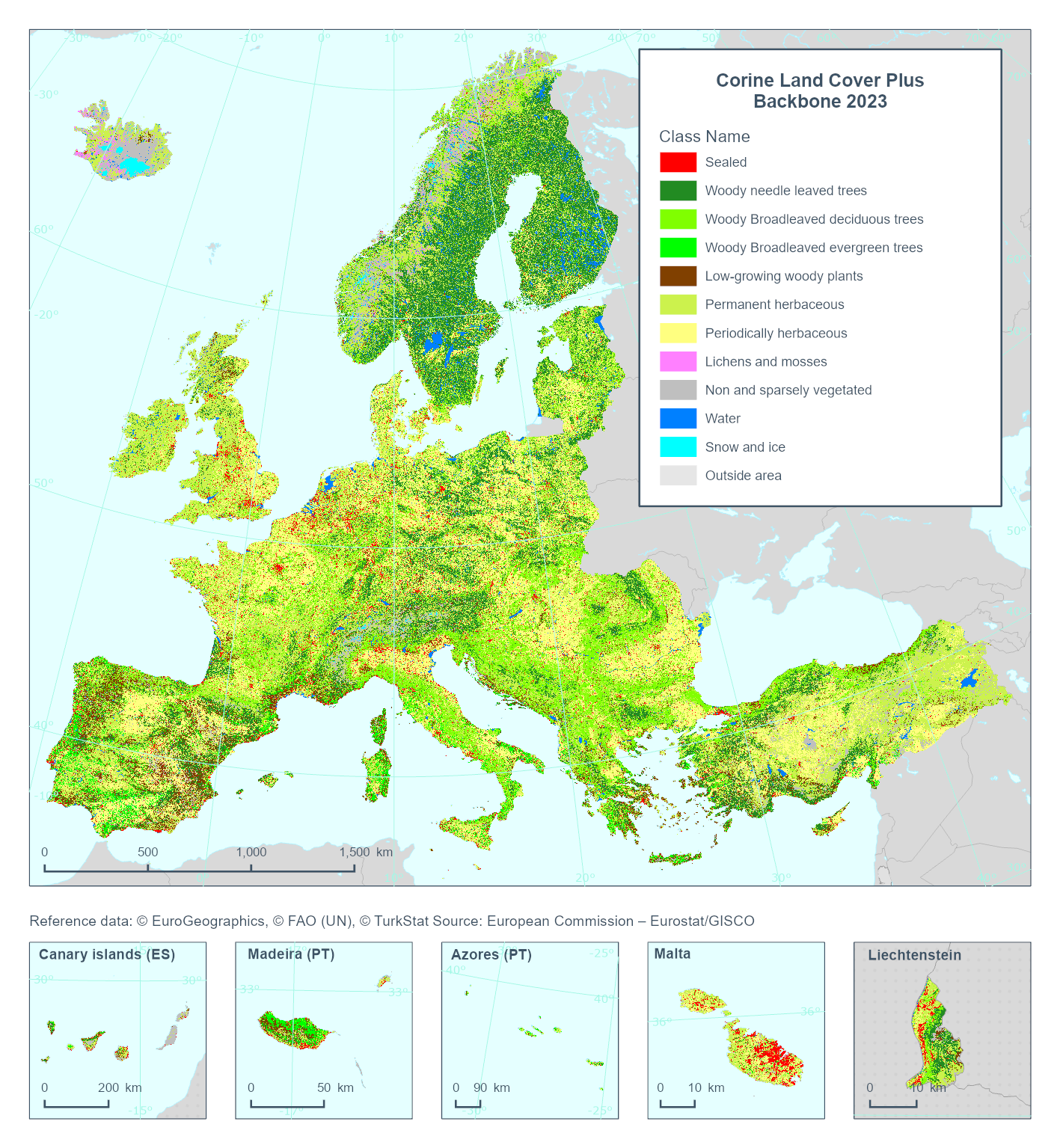
This metadata refers to the Corine Land Cover plus Backbone (CLCplus Backbone), a spatially detailed, large-scale, Earth Observation-based land cover inventory which is produced by the Copernicus Land Monitoring Service (CLMS). The CLCplus Backbone is a high-resolution raster land cover map based on Sentinel-2 satellite time series. Each 10m-pixel contains the dominant land cover among the 11 basic land cover classes. See pixel class codes in the 'Additional Information' section below. The product is available from the 2018 reference year, with a first update produced for the 2021 reference year and moved to an update cycle of 2 years from 2021 onwards.
-
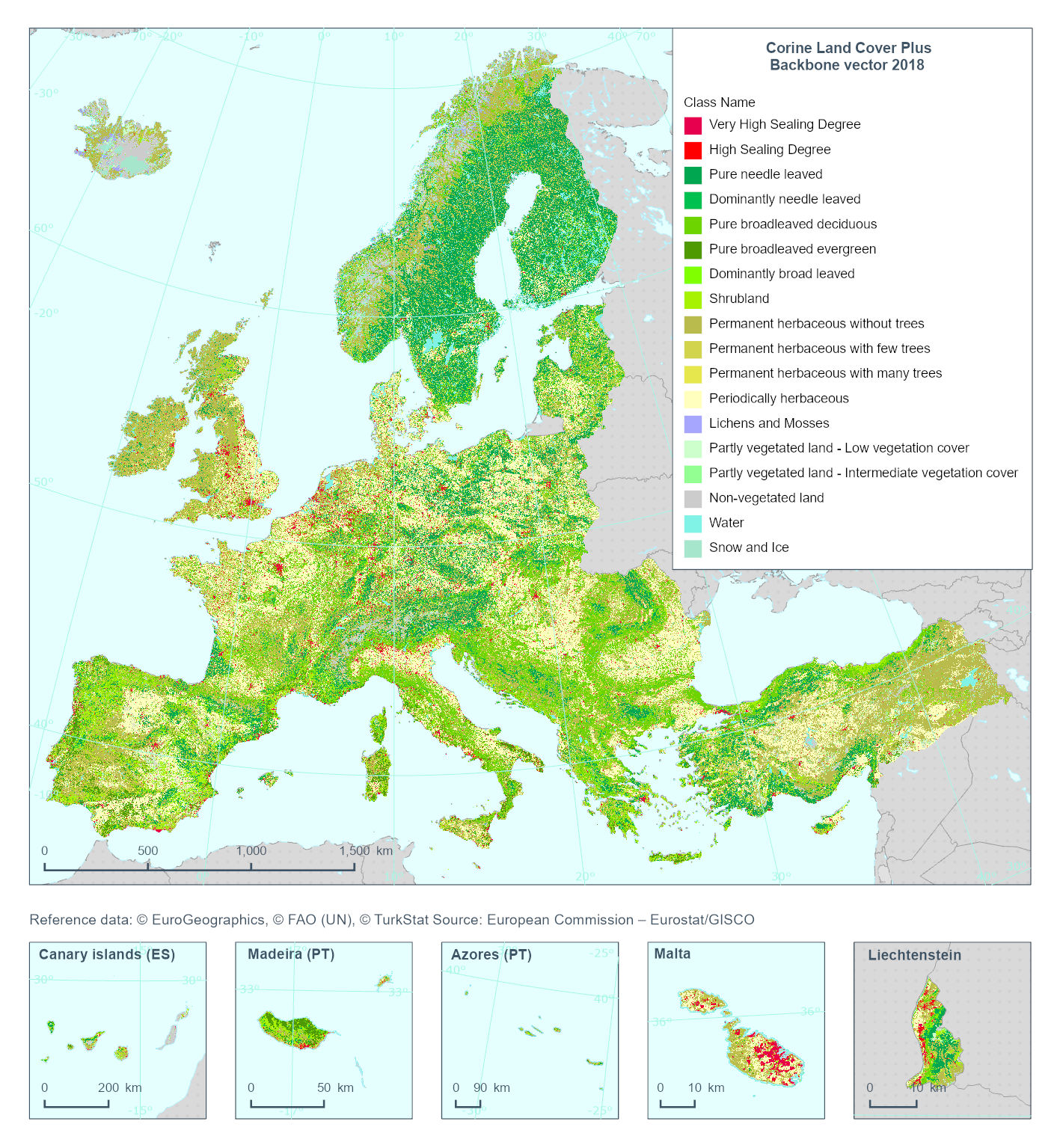
This metadata refers to the 'Corine Land Cover Plus Backbone' (CLCplus Backbone), a spatially detailed, large-scale, Earth Observation-based land cover inventory which is produced by the Copernicus Land Monitoring Service (CLMS). The CLCplus Backbone vector is a land cover map that contains vector polygon geometries (minimum mapping unit: 0.5 ha; minimum mapping width: 20 m) and is based on Sentinel satellite time series and a combination of existing reference datasets for geometries containing transportation and hydrological networks. Each polygon represents aggregated landscape objects and contains their dominant land cover among the 18 basic land cover classes. See polygon class codes in the additional information section. In addition, polygons are enriched with land cover fractions from the CLCplus Backbone raster as well as aggregated attributes based on other CLMS and Copernicus products (e.g. topography). CLCplus Backbone vector is an independent product and its thematic and geometric contents differ from CLCplus Backbone raster and Corine Land Cover. The CLCplus Backbone vector is available for the 2018 reference year.
-
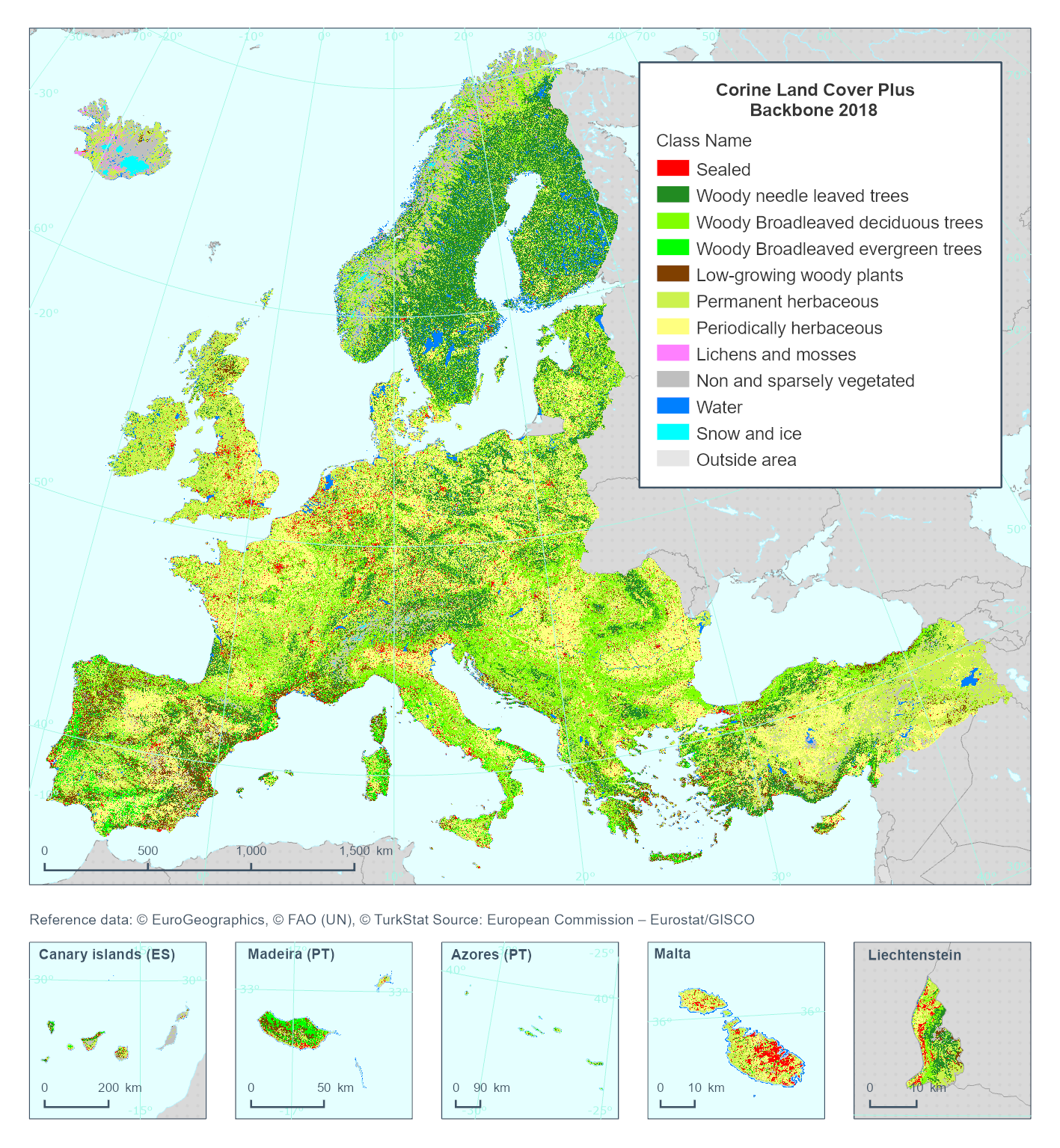
This metadata refer to the 'Corine Land Cover plus Backbone' (CLCplus Backbone) which is a spatially detailed, large scale, Earth Observation-based land cover inventory. The CLCplus Backbone Raster Product is a 10m pixel-based land cover map based on Sentinel satellite time series from July 2017 to June 2019. For each pixel it shows the dominant land cover among the 11 basic land cover classes. The product has a three years update cycle and is available for the 2018 reference year.
-
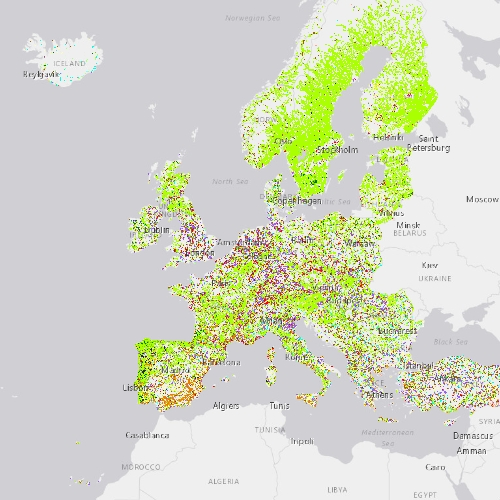
Riparian zones represent transitional areas occurring between land and freshwater ecosystems, characterised by distinctive hydrology, soil and biotic conditions and strongly influenced by the stream water. They provide a wide range of riparian functions (e.g. chemical filtration, flood control, bank stabilization, aquatic life and riparian wildlife support, etc.) and ecosystem services. The Riparian Zones products support the objectives of several European legal acts and policy initiatives, such as the EU Biodiversity Strategy to 2020, the Habitats and Birds Directives and the Water Framework Directive. This metadata refers to the Riparian Zones Land Cover/Land Use (LC/LU) change for 2012-2018. The LC/LU classification is tailored to the needs of biodiversity monitoring in a variable buffer zone of selected rivers (Strahler levels 2-9 derived from EU-Hydro) for the change layer 2012-2018. LC/LU is extracted from Very High Resolution (VHR) satellite data and other available data in a buffer zone of selected rivers for supporting biodiversity monitoring and mapping and assessment of ecosystems and their services. The class definitions follow the pre-defined nomenclature on the basis of Mapping and Assessment of Ecosystems and their Services (MAES) typology of ecosystems (Level 1 to Level 4) and CORINE Land Cover. The classification provides 55 distinct thematic classes with a Minimum Mapping Unit (MMU) of 0.5 ha and a Minimum Mapping Width (MMW) of 10 m. The production of the Riparian Zones products was coordinated by the European Environment Agency in the frame of the EU Copernicus programme.
-
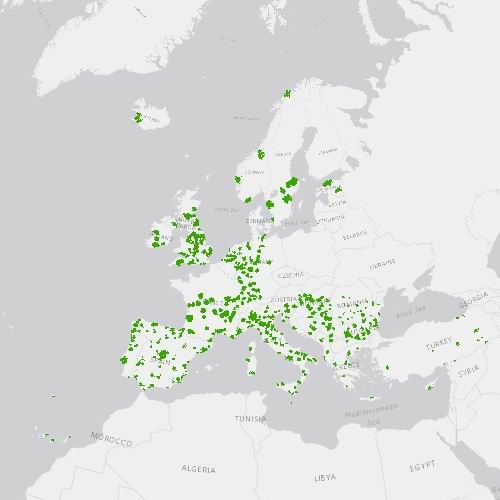
The Urban Atlas provides pan-European comparable land use and land cover data for Functional Urban Areas (FUA) across EEA38 countries (EU, EFTA, Western Balkan countries as well as Türkiye) and United Kingdom. The Street Tree Layer (STL) is a separate layer from the Urban Atlas 2018 LU/LC layer produced within the level 1 urban mask for each FUA. It includes contiguous rows or a patches of trees covering 500 m² or more and with a minimum width of 10 meter over 'Artificial surfaces' (nomenclature class 1) inside FUA (i.e. rows of trees along the road network outside urban areas or forest adjacent to urban areas should not be included). Urban Atlas is a joint initiative of the European Commission Directorate-General for Regional and Urban Policy and the Directorate-General for Defence Industry and Space in the frame of the EU Copernicus programme, with the support of the European Space Agency and the European Environment Agency.
-
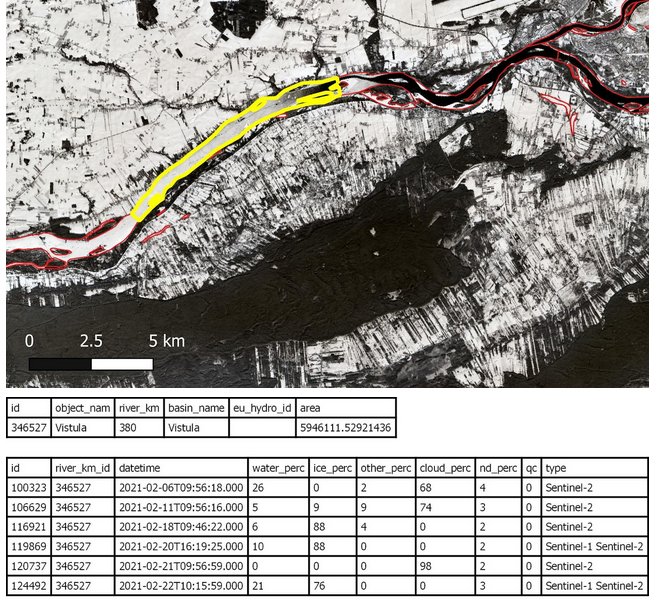
The Aggregated Water and Ice (AWIC) product is a spatially aggregated information on surface water conditions of rivers and lakes. AWIC information is stored in a geodatabase, enriched every day from the different Water/Ice Cover products (WIC S1, WIC S1, WIC S1+S2) for the entire EEA38 and the United Kingdom. It provides percent coverage of snow-covered or snow-free ice on lakes and on 10 km river sections described by the EU-HYDRO river and lake network database. AWIC data is stored in a PostGIS persistent geodatabase. They can be retrieved by using a specific REST API. Users can query ice sheet summary information of river segments and lakes (AWIC statistics) together with the geometry and caracteristics of the features on which these statistics were estimated. All geometry features are delivered in the ETRS89 LAEA (EPSG:3035) coordinate reference system. AWIC is one of the products of the pan-European High-Resolution Water, Snow and Ice service (HR-WSI), which are provided at high spatial resolution from the Sentinel-2 and Sentinel-1 constellations data from September 1, 2016 onwards.
-
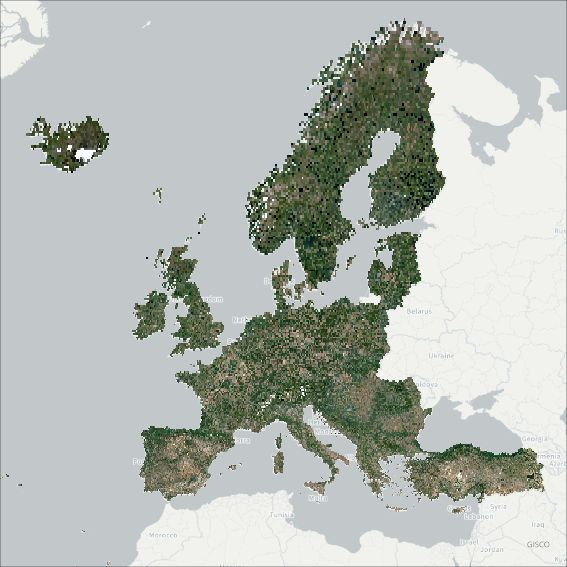
The pan-European Very High Resolution (VHR) Image Mosaic 2021 is a seamless mosaic of the VHR 2021 dataset. The input data consists of a mix of Pleiades, SuperView, Worldview, Kompsat-3, Kompsat-4, Geoeye, SPOT, Deimos-2, Vision-1 and TripleSat images. To enhance the appearance of the input imagery, a histogram stretch was applied, cutting off the lowest and highest 0.1 percent of the histogram values and stretching the remaining values to fit the 16-bit pixel depth. For each input image, only selected areas were used to create the mosaic, and the rest was masked out to exclude areas with clouds and their shadows. Color balance was achieved using a second-order method, which modifies all input pixels toward a set of multiple points derived from a two-dimensional polynomial parabolic surface, ensuring a seamless mosaic. For several water bodies, especially large lakes, the final result exhibited a patchy surface pattern due to presence of sun glint on the satellite images. A post-processing methodology was implemented to recalculate the digital values to produce a seamless appearance surface of some of these major lakes: Vänern and Vättern (Sweden), Oulu (Finland), Peipus (Estonia), Geneva (Switzerland/France), Constance (Switzerland/Germany/Austria), Garda and Bolsena (Italy), Skadar (Montenegro/Albania), Prespa (North Macedonia/Albania/Greece), Beysehir, Iznik and Van (Turkey). The applied methodology consisted of creating individual mosaics with the images comprising only the mentioned lakes (a mosaic per lake), calculating Normalized Difference Vegetation Index (NDVI) for shoreline extraction, and color balancing each mosaic individually with all land surfaces masked out, using only pixels belonging to the water category. This approach allowed smoothing the patchy surfaces of the above-mentioned lakes considering statistics solely from the water pixels, ensuring a more uniform appearance. To enhance the visualization of the entire dataset at larger scales (greater than 1:500.000), the mosaic displays pan-European overviews generated from the pan-European Very High Resolution 2018 Image Mosaic. The updated VHR 2021 version is visualized only at scales below 1:500.000. The mosaic primarily is used as input data in the production of various Copernicus Land Monitoring Service (CLMS) datasets and services, such as land cover maps and high-resolution layers on land cover characteristic. It can be also useful for CLMS users for visualizations and classifications on land. The input imagery for the creation of the mosaic is provided by ESA. Due to license restrictions, the VHR Image Mosaic 2021 is only available as a web map service (WMS), and not for data download.
-

The Sentinel-2 Snow Phenology (SP S2) product is generated once a year at European scale, based on Fractional Snow Cover (FSC) products calculated from Sentinel-2 optical data. This product describes the snow season in terms of temporality as it provides, within an hydrological year and for each pixel, the number of days with snow cover, as well as the first and the last day of the longest observed snow period. It has a spatial resolution of 20 m x 20 m, as does the input FSC product. The SP S2 product is distributed in raster files covering an area of 110 km by 110 km with a pixel size of 20 m by 20 m in UTM/WGS84 projection, which corresponds to the Sentinel-2 input L1C product tile. Each product is composed of separate files corresponding to the different layers of the product, and another metadata file." The product is also available in another projection as tiles aligned with the Pan-European High-Resolution Layers in the European grid (ETRS89 LAEA - EPSG: 3035) at 20 m x 20 m and 100 m x 100 m. SP S2 is one of the products of the pan-European High-Resolution Water Snow & Ice portfolio (HR-WSI), which are provided at high spatial resolution from the Sentinel-2 and Sentinel-1 constellations data from September 1, 2016 onwards.
-

The Sentinel-1 and Sentinel-2 Snow Phenology (SP S1+S2) product is generated once a year over high-mountain areas at European scale, based on daily cumulative Gap-Filled Fractional Snow Cover (GFSC) products calculated from Sentinel-2 optical and Sentinel-1 radar data. This product describes the snow season in terms of temporality as it provides, for each pixel, the number of days with snow cover, as well as the first and the last day of the longest observed snow period. It has a spatial resolution of 100 m x 100 m. Each product is composed of separate files corresponding to the different layers of the product, and another metadata file. The product is also available in another projection as tiles aligned with Sentinel-2 (UTM/WGS84) at 60 m x 60 m. SP S1+S2 is one of the products of the pan-European High-Resolution Water Snow & Ice portfolio (HR-WSI), which are provided at high spatial resolution from the Sentinel-2 and Sentinel-1 constellations data from September 1, 2016 onwards. t.
-

The Woody Vegetation Layer is a new product that aims at providing information about presence or absence of woody vegetation of any type across Europe without any differentiation of height, size or nature and without masking forested areas. It includes isolated trees or permanent crops such as orchards. This helps users understand the distribution of these features across different regions and provide an “all tree layer” that users can use to derive their own application. The production of the HRL Small Landscape Features is coordinated by EEA in the frame of Copernicus, the Earth observation component of the European Union’s Space programme. The product is a raster dataset with 5-meter grid spacing (spatial resolution), distributed as 100 x 100 km tiles that are fully conformant with the EEA reference grid.
 Arctic SDI catalogue
Arctic SDI catalogue